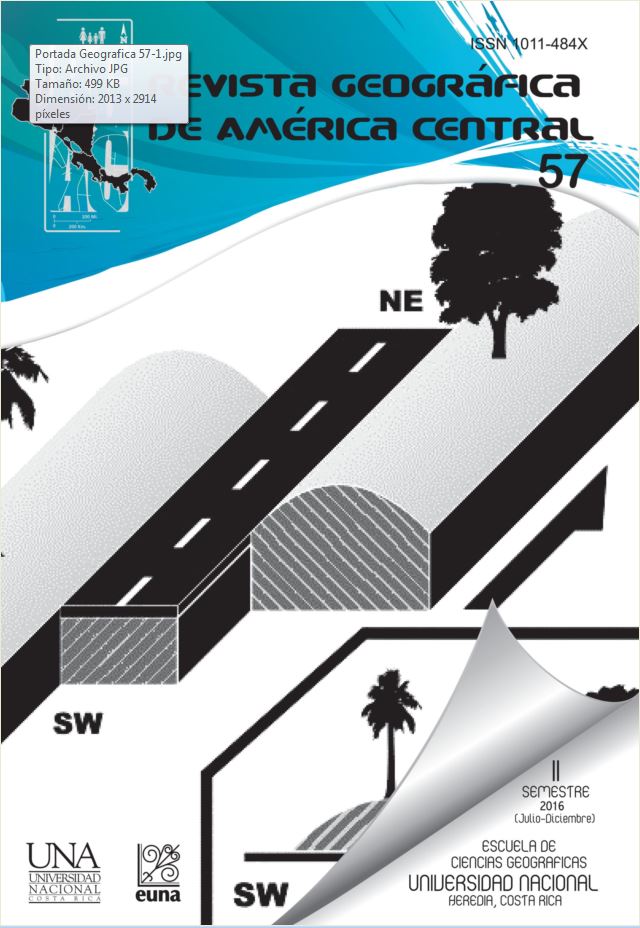LA FALLA ACTIVA GUANE, CUBA OCCIDENTAL
DOI:
https://doi.org/10.15359/rgac.57-2.6Palabras clave:
Cuba, falla, sismotectónica, sismicidad de interior de placa, terremotoResumen
Se presentan nuevos datos que confirman la actividad de la falla Guane. Ésta es una estructura activa de interior de placa en la Unidad Neotectónica Occidental de Cuba con ~100. La magnitud máxima de los terremotos es 6.2 con periodo de recurrencia de ~130 años. El mecanismo tectónico de reajustes en el interior de la placa es a través de fallas y rotación de bloques, que producen terremotos como los de: 23.01.1880 (San Cristóbal, Cuba), 16.12.1982 (Torriente - Jagüey Grande, Matanzas) y 09.03.1995 (Pedro Pí - San José de las Lajas, La Habana). Esos 3 terremotos se pueden explicar a partir de procesos transpresivos de las placas Caribe y Norteamérica en las fallas Swan y Oriente, y de la transmisión de esfuerzos hacia el megabloque Cuba.
Referencias
Allen, C.R. (1975). Geological criteria for evaluating seismicity. Geo.Mar.Lett., 86(8), 1041-1057.
Álvarez, H. (1992). Mecanismos tectónicos y desarrollo estructural de la Sierra de los Órganos. Revista Minería y Geología, 1, 11-18.
Álvarez, H. (1989). Secuencia estratigráfica olitrostómica y estructura de la depresión de San Diego; implicaciones en la tectónica de la Sierra de los Órganos. Resúmenes del I Congreso Cubano de Geología, La Habana, Cuba.
Álvarez, H. (1981). Síntesis de la evolución geotectónica de la Sierra de los Órganos apoyada en el estudio de la geología del Valle de Pons. Informe del Centro Universitario de Pinar del Río, 272 p.
Álvarez, L., Chuy, T., García, J., Moreno, B., Álvarez, H., Blanco, M., Expósito, O., González, O. and Fernández, A.I. (1999). An earthquake catalogue of Cuba and neighbouring areas. The Abdus Salam International Centre for Theoretical Physics, Miramare - Trieste. Internal Report IC/IR/99/1, 60 p.
Álvarez, L., Serrano, M., Rubio, M., Chuy, T., and González, B. (1984). El terremoto del 19 de febrero de 1976. Pilón, región oriental de Cuba. Revista Investigaciones Sismológicas en Cuba, 5, 5-60.
Angelier, J., Bergerat, F., Bellou, M. and Homberg, C. (2004). Co-seismic strike-slip displacement determined from push-up structures: the Selsund fault case, South Iceland. Jour.Struc.Geol., 26, 709-724.
Balboa, I. (2010). Libertos, vagos y bandoleros. La reglamentación del trabajo tras la abolición de la esclavitud, Cuba, 1886-1895. Relaciones, 127, 31 p.
Butticaz, P. (1946A). Geological map Río Leña, scale 1:20000, Cuba. Archivo Nacional del Fondo Geológico.
Butticaz, P. (1946B). Cuban geological report, N° 10 of Standard Oil Corporation. 30 p. Archivo Nacional del Fondo Geológico.
Campbell, D.L. (1978). Investigation of the stress concentration mechanism for intraplate earthquakes. Geophys.Res.Lett., 5, 477-479.
Chuy,T. (1989). Isosistas de terremotos de Cuba. Nuevo Atlas Nacional de Cuba. Sección Características Geofísicas, II.3.2. Madrid.
Cotilla, M.O. (2014). Alternative interpretation for the active zones of Cuba. Geotectonics, 48(6), 459-483.
Cotilla, M.O. (2007). Un recorrido por la Sismología de Cuba. Editorial Complutense, Madrid. ISBN 97-8-47- 491827-4.
Cotilla, M.O. (2003). The Santiago de Cuba earthquake of 11 June 1766: Some new insights. Geofísica Internacional, 42(4), 589-602.
Cotilla, M.O. (1999). El controvertido alineamiento Habana-Cienfuegos, Cuba. Estudios Geológicos, 55(1-2), 67-88.
Cotilla, M.O. (1995). El sismo del 09.03.1995 en Ganuza, San José de las Lajas. Informe del Instituto de Geofísica y Astronomía, Ministerio de Ciencia, Tecnología y Medio Ambiente de Cuba, 10 p.
Cotilla, M.O. and Álvarez, J.L. (2001). Regularidades sismogenéticas de la unidad neotectónica Occidental de Cuba. Revista Geológica de Chile, 28(1), 3-24.
Cotilla, M. and Córdoba, D. (2011). Study of the earthquake of the January 23, 1880, in San Cristóbal, Cuba and the Guane fault. Izvestiya Physics of the Solid Earth, 47(6), 496-518.
Cotilla, M. and Córdoba, D. (2010A). Study of the Cuban fractures. Geotectonics, 44(2), 176-202.
Cotilla, M. and Córdoba, D. (2010B). The Bayamo earthquake (Cuba) of the 18 October 1551. International Journal of Geosciences, 1, 1-13.
Cotilla, M. and Córdoba, D. (2010C). The August 20, 1852 earthquake in Santiago de Cuba. Russian Geology and Geophysics, 51, 1227-1246.
Cotilla, M. and Córdoba, D. (2008). Notes on three earthquakes in Santiago de Cuba (14.10.1800, 18.09.1826, 07.07.1842). Russian Geology and Geophysics, 51, 243-251.
Cotilla, M.O. and Franzke, H.J. (1999). Validación del mapa sismotectónico de Cuba. Boletín Geológico y Minero, 10(5), 21-28.
Cotilla, M. and Udías, A. (1999). Geodinámica del límite Caribe-Norteamérica. Rev.Soc.Geol. de España, 12(2), 175-186.
Cotilla, M.O., Franzke, H.J. and Córdoba, D. (2007). Seismicity and seismoactive faults of Cuba. Russian Geology and Geophysics, 48, 505-522.
Cotilla M., Millán G., Álvarez L., González D., Pacheco M. and Arteaga F. (1993). Elementos del esquema neotectogénico de Cuba. Informe científico-técnico, Instituto de Geofísica y Astronomía. Ministerio de Ciencia, Tecnología y Medio Ambiente de Cuba, 100 p.
Cotilla, M.O., Rubio, M., Álvarez, L. and Grünthal, G. (1997). Potenciales sísmicos sector Centro-Occidental del arco de Las Antillas Mayores. Revista Geofísica, 46, 127-150.
Cotilla, M., González, E.C., Cañete, C.C., Díasa J.L., and Carral, R. (2003). La red fluvial de Cuba y su interpretación morfoestructural. Revista Geográfica, 134, 47-74.
Cotilla, M., Cañete, C., Díaz J.L. and Carral, R. (1992). Evaluación de las mejores localidades para los emplazamientos nucleares de Cuba Centro-Oriental. Informe del Centro de Investigaciones Sismológicas, Academia de Ciencias de Cuba, 30 p.
Cotilla, M., Bankwitz, P., Franzke, H.J., Álvarez, L., González, E., Díaz, J.L., Grünthal, G., Pilarski, J. and Arteaga, F. (1991A). Mapa sismotectónico de Cuba, escala 1:1000000. Comunicaciones Científicas sobre Geofísica y Astronomía, 23, 35 p.
Cotilla M., González, E.C., Franzke, H.J., Díaz, J.L., Arteaga, F. and Álvarez, L. (1991B). Mapa neotectónico de Cuba, escala 1:1000000. Comunicaciones Científicas sobre Geofísica y Astronomía, 22, 37 p.
Cotilla, M., Franzke, H.J., Pilarski, J., Pilarski, M., and Álvarez, L. (1991C). Mapa de alineamientos y nudos tectónicos principales de Cuba, a escala 1:1000000. Revista Geofísica, 35, 53-112.
Cuevas T. (1900). La trocha de Mariel a Majana. Imprenta del Cuerpo de Artillería del Ejército Español. Madrid.
Cuevas, J., Sala, G. and Padrón, A. (2001). 500 años de construcciones en Cuba. Edited by D.V. Chavin. Servicios Gráficos y Editoriales, S.L., La Habana, 557 p.
Díaz, A. (1989). Curvas de duración de caudales. Mapa de Cuba a escala 1:2000000. Nuevo Atlas de Cuba, Sección Recursos Hídricos, VII.1.2, Madrid.
Díaz, J.L. and Lilienberg, D.A. (1989). Nuevos datos sobre los movimientos recientes de Cuba Occidental. Reporte de Investigación del Instituto de Geografía, 4, 11 p.
Erickson, A.J., Helsley, C.E. and Simmons, G. (1972). Heat flow and continuous seismic profiles in the Cayman trough and Yucatan basin. Geol.Soc. of Am.Bull., 83, 1241-1260.
Frohlich, C. (1982). Seismicity of the Central Gulf of Mexico. Geology, 10, 103-106.
Fuchs, Cw. C (1882). Die vulkanischen Ereignise des Jahres 1880. 16 Jahres bericht Mineral. Un. Petrographi. Mittelungen, Neue Folge, Band IV (pp. 51-96).
González, J.S. (2003). Tres siglos de compromiso evangelizador. In: Pinar del Río 300 años de compromiso evangelizador. Ediciones Vitral (Editor: J. Gaiga), Cap. XIV (pp. 107-140).
González, B.E., Álvarez, J., Serrano, M., García, J., Rodríguez, V., Pérez, L. and Fernández, E. (1995). Informe científico-técnico del 9 de marzo de 1995: Ganuza, Municipio San José de las Lajas. Archivo del Centro Nacional de Investigaciones Sismológicas, Filial Occidental. Ministerio de Ciencia, Tecnología y Medio Ambiente de Cuba, 13 p.
González, E.C., Cotilla, M.O., Cañete, C.C., Díaz, J.L., Carral, R. and Arteaga, F. (2003). Estudio morfoestructural de Cuba. Geogr.Fis.Dinam.Quat., 26, 49-69.
Guelfand, I.M., Guberman, S.A., Keylis-Borok, V.I., Knopoff, L., Press F.S., Rantsman, E.Y., Rotvain, I.M. and Skii, A.M. (1976). Condiciones de surgimiento de terremotos fuertes (California y otras regiones). Vichislitielnaya Seismologiya, 9, 3-91.
Hatter, K.M., Michael, N. and Richard, L.D. (1993). Guidelines for US database and map for the maps of major active faults, western hemisphere. International Lithosphere Program (ILP), Proj. II-2. US Depart of Interior, US Geological Survey, 45 p.
Heubeck, Ch. and Mann, P. (1990). Geologic evaluation of plate kinematic model for the Northamerican-Caribbean plate boundary zone. Tectonophysics, 191, 1-26.
Johnston A.E. and Kanter L.R. (1990). Earthquakes in stable continental crust. Sci.Am., 262(3), 68-75.
Karakhanian, A.S., Trifonov, V.G., Ivanova, T.P., Avagyan, A., Rukieh,, M., Minini, H., Dodonoy, A.E. and Bachmanoy, D.M. (2008). Seismic deformation in the St. Simeon Monasteries (Qal’ at Sim’an), northwestern Syria. Tectonophysics, 453, 122-147.
Lay, T. and Wallace, T.C. (1995). Modern global seismology. International Geophysics Series, 58. Academic Press, San Diego, California.
Liu, L. and Zoback, M.D. (1977). Lithospheric strenghts and intraplate seismicity in the New Madrid seismic zone. Tectonics, 16, 585-595.
LeRoy, S.D. (1998). Treating the Gulf of Mexico as a continental margin petroleum province. The Leading Edge, 1, 209-212.
Machette, M., Personius, S., Nelson, A., Schwartz, D. and Lund, D. (1991). The Wasatch fault zone, Utah: segmentation and history of the Holocene earthquakes. J.Struct.Geol., 13(2), 137-149.
Mackey, K.G., Fiyita, K., Gunbina, L.V., Kovalev, V., Imaev, V., Koz'min, B. and Imaeva, L. (1997). Seismicity of the Bering Strait region: Evidence for Bering block. Geology, 25(11), 979-982.
Makarov, G.V., and Schukin, Yu.K. (1976). Valoración de las fallas ocultas. Geotectonika, 1, 96-109.
Makarov, V.I., Dorozhko, A.L., Makarova, N.V. and Makeev, V.M. (2007). Contemporary geodynamically active zones of platforms. Geoekologiya, 2, 99-110.
Martínez, J.B. (2003). Regulación del escurrimiento con régimen hidrológico alterado. Ingeniería Hidraúlica y Ambiental, 24(2), 1-8.
Nikonov, A.A. (1997). Collapse of Antique Diosconia and Sebas Topolis as a result of seismic impacts. Geoekologiya, 4, 104-115.
NUREG-1451 (1992). Staff technical position on investigations to identify fault displacements and seismic hazards at a geologic repository. McCornell, K.I., Blackford, M.E. and Ibrahim, A.K. US Nuclear Regulatory Commission Washington, D.C. 20555.
Oficina Nacional de Estadísticas de la República de Cuba (2010). AE- Anuario estadístico. Separata de Pinar del Río.
Orbera, L., González, B., Chuy, T. and Oro, J. (1990). Investigaciones sísmicas en la región de emplazamiento del Centro de Investigaciones Nucleares. Vol. I, Secretaría Ejecutiva de Asuntos Nucleares, Cuba, 344 p.
Philip, H., Rogozhin, E., Cisternas, A., Bousquet, J.C., Borisov, B. and Karakhanian, A. (1992). The Armenian earthquake of 1988, December 7: Faulting and folding, neotectonics and paleoseismicity. Geoph.Jour.Int., 110, 141-158.
Pichardo, E. (1872). Carta geográfica de la Isla de Cuba. Madrid.
Pichardo, E. (1855). Carta geográfica de la Isla de Cuba. Madrid.
Reiter, L. (1990). Earthquake hazard analysis. Colombia University Press, New York, 254 p.
Rockwood, C.G. (1880). Notices of recent American earthquakes. American Journal of Sciences, 19(9), 25-299.
Rosencratz, E. (1990). Structure and tectonic of the Yucatan basin, Caribbean Sea, as determine from seismic reflection studies. Tectonics, 9(5), 1037-1059.
Rosencratz, E. and Mann, P. (1991). Mapping of transform faults in the Cayman trough, Caribbean Sea. Geology, 19, 690-693.
Rosencratz, E., Ross, M.I. and Sclater, J.G. (1988). Age and spreading history of the Cayman trough as determined from depth, heat flow and magnetic anomalies. J.Geophys.Res., 93, 2141-2157.
Sbar, L. and Sykes, L.R. (1973). Contemporary compressive stress and seismicity in Eastern North America: An example of intraplate tectonics. Geol.Soc.Am.Bull., 84, 1861-1882.
Secretaría de Economía de México (1956). Estadísticas Sociales del Porfiriato 1877-1910. Dirección General de Estadística. Edited by Talleres Gráficos de la Nación. México.
Smirnov, V.B., Chadka, R.K., Ponomarev, A.V. and Srinagesh, D. (2013). Prognostic anomalies of induced seismicity in the region of the Koyna-Warna water reservoirs, West India. Izvestiya, Physics of the Solid Earth, 49(2), 243 p.
Stein, R.S. (1999). The role of stress transfer in earthquake occurrence. Nature, 402, 605-609.
Sykes, L.R. (1978). Intraplate seismicity reactivation of prexisting zones of weakness, alkaline magmatism and tectonic postdating continental fragmentation. Reviews of Geophysics and Space Physics, 16(4), 621-688.
Sylvester, A.G. (1988). Strike-slip faults. Geol.Soc.Am.Bull., 100 ,1666-1703.
Taber S. (1922). The seismic belt in the Greater Antilles. Bull.Seism.Soc.Am., 12(4), 199-219.
Trifonov, V.G. and Kozhurin, A.I. (2010). Study of active faults: Theoretical and applied implications. Geotectonics, 44(6), 510-528.
Trifonov, V.G. and Machette, N.M. (1993). The world map of major active faults project. Annali di Geofísica, 36(3-4), 225-236.
USGS. (2006). Earthquake Hazard Program. Earthquake Summary Poster. (http://earthquake.usgs.gov/eqcenter/eqarchives/poster/2006/20060910.php).
Van der Plujim, B.A., Craddock, J.P., Graham, B.R. and Harris, J.H. (1997). Paleostress in cratonic North-America: Implications for deformation of continental interiors. Science, 277, 794-796.
Viñes, B. and Salteraín, P. (1880). Excursión a Vuelta Abajo de Viñes y Salteraín en ocasión de los fuertes temblores de tierra ocurridos en la noche del 22 al 23 de enero de 1880. Ediciones La Voz de Cuba. La Habana, 68 p.
Wilcox, R.E. and Seely, D.R. (1973). Basic wrench tectonics. American Association of Petroleum Geologists Bull., 57(1), 74-96.
Wooters, B. (1986). Seismicity and tectonics of southern Central America and adjacent regions with special attention in to the surrounding of Panama. Tectonophysics, 128, 21-46.
Zhidkov, M.P., Rotvain, I.M. and Sadowskii, A.M. (1975). Pronóstico del lugar de posible ocurrencia de terremotos fuertes. Intersecciones múltiples de lineamientos de la Meseta Armeniana. Vichislitielnaya Seismologiya, 8, 53-70.
Zoback, M.L. (1992). First- and second- order patterns of stress in the lithosphere: The World stress map project. J.Geophys.Res., 97, 11703-11728.
Descargas
Publicado
Cómo citar
Número
Sección
Licencia
Política propuesta para Revistas que ofrecen Acceso Abierto
Los autores que publican en esta revista están de acuerdo con los siguientes términos:
a. Los autores conservan los derechos de autor y garantizan a la revista el derecho de ser la primera publicación del trabajo, bajo la Licencia https://creativecommons.org/licenses/by-nc-sa/4.0/deed.es, que permite a otros compartir con un reconocimiento de la autoría del trabajo y la publicación inicial en esta revista.
b. Los autores pueden establecer por separado acuerdos adicionales para la distribución no exclusiva de la versión de la obra publicada en la revista (por ejemplo, situarlo en un repositorio institucional o publicarlo en un libro), con un reconocimiento de su publicación inicial en esta revista. Esos acuerdos adicionales deben respetar los términos de la licencia: es decir: no involucrar fines de lucro y compartir con la misma licencia.
c. Se anima a los autores a archivar el post-print o versión de editor/PDF en repositorios de acceso abierto.







 REVGEO se encuentra bajo la licencia https://creativecommons.org/licenses/by-nc-sa/4.0/deed.es
REVGEO se encuentra bajo la licencia https://creativecommons.org/licenses/by-nc-sa/4.0/deed.es
.svg_4.png)

_(1).png)
_(1)_(1)_(1)_1.png)
(2)(1)(1)(1).png)
